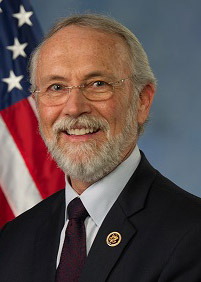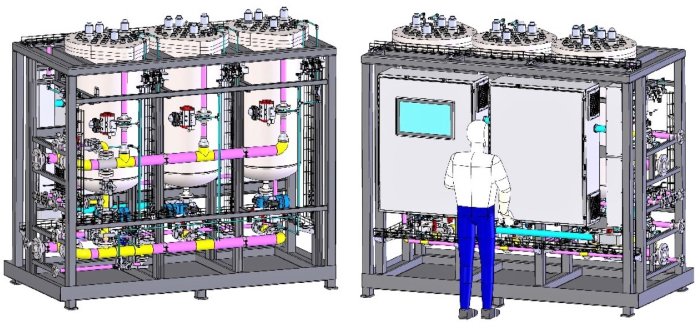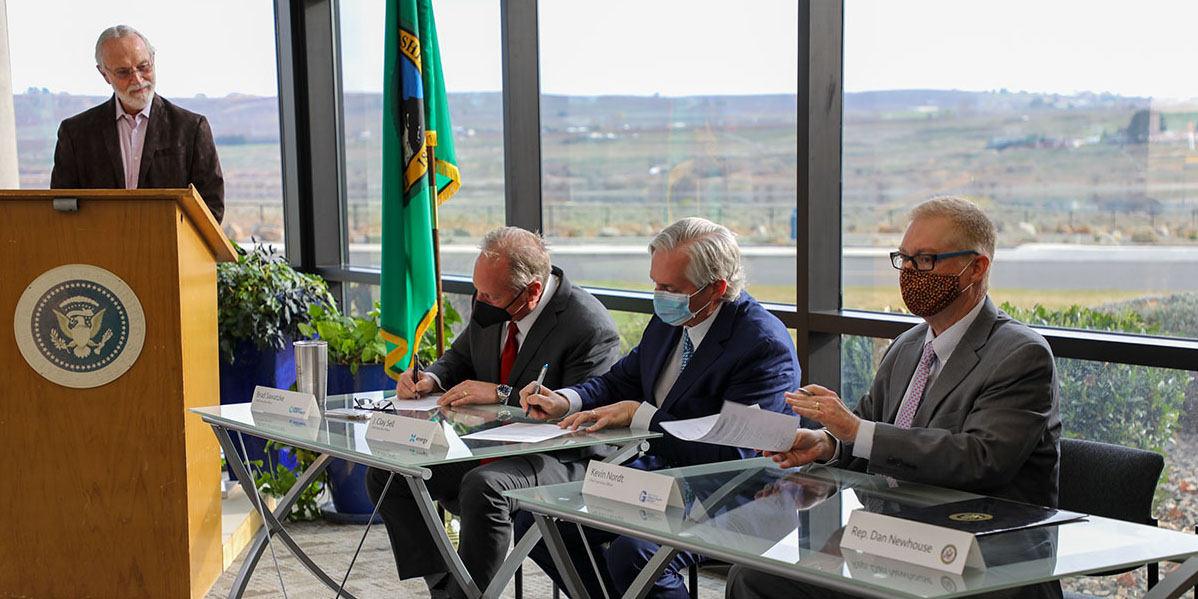Webinar subject matter: Neutrinos and nuclear reactors

A free webinar on the subject of "The Curious History of Neutrinos and Nuclear Reactors" will be held on Friday, April 9, from 10:30 to 11:30 a.m. (EDT). Registration is required.

A message from Electrical Builders, Ind.
America’s Top Performing Nuclear Plants Rely on Electrical Builders, Industries to Expand and Extend the Life of Their Critical Electrical Assets

A free webinar on the subject of "The Curious History of Neutrinos and Nuclear Reactors" will be held on Friday, April 9, from 10:30 to 11:30 a.m. (EDT). Registration is required.

Newhouse
In a letter written to Energy Secretary Jennifer Granholm, Rep. Dan Newhouse (R., Wash.) has urged the Department of Energy to maintain its 2019 interpretation of high-level radioactive waste. Newhouse was responding to a letter sent to Granholm by several special interest groups and state leaders asking that the DOE immediately rescind the HLW interpretation.
That special interests/state leaders letter, sent on February 26—one day after Granholm was confirmed as energy secretary—was signed by Washington attorney general Bob Ferguson, Washington State director of ecology Laura Watson, and Phil Rigdon of the Yakama Nation, along with representatives from Natural Resources Defense Council, Hanford Challenge, and Columbia Riverkeeper. The letter said, in part, “We look forward to working with you on the Department’s cleanup of legacy nuclear waste at sites such as the Hanford Nuclear Reservation located near Tri-Cities, Washington. Washington houses 60 percent of the nation’s High-Level Radioactive Waste with 56 million gallons stored in 177 underground storage tanks at Hanford."

Unit 1 at the United Arab Emirates’ Barakah nuclear power plant has entered commercial operation and is now providing “constant, reliable, and sustainable electricity around the clock,” the Emirates Nuclear Energy Corporation (ENEC) announced this morning. ENEC added that, as a result of the event, the company now leads the largest decarbonization effort of any industry in the UAE.

Scientists at the DIII-D National Fusion Facility have published research on a compact fusion reactor design they say could be used to develop a pilot-scale fusion power plant. According to General Atomics (GA), which operates DIII-D as a national user facility for the Department of Energy’s Office of Science, the Compact Advanced Tokamak (CAT) concept uses a self-sustaining configuration that can hold energy more efficiently than in typical pulsed configurations, allowing the plant to be built at a reduced scale and cost.

Craig Piercy
Madam Secretary:
Congratulations on becoming America’s 16th secretary of energy! Welcome to one of the most misunderstood, confounding, yet important and underappreciated agencies in the federal government.
Even the name—the U.S. Department of Energy—is misleading. Given that the majority of its funding and operational focus is dedicated in some form or another to the splitting and fusing of atoms, the DOE should probably be called the Department of Nuclear Technology and Other Energy and Science Stuff.

Around the world, national and local policymakers and business leaders are making bold and ambitious commitments to clean energy goals. In the United States, one in three Americans now lives in a city or state that has committed to or has achieved 100 percent clean electricity, according to the Luskin Center for Innovation at the University of California–Los Angeles.

Mary Lou Dunzik-Gougar
Happy spring to you, my nuclear comrades. As I write this column (in early March), I’m glancing out the window at the 10 inches of snow still remaining in my backyard. By the time you read this, the snow may be gone, and spring flowers may be poking out of the earth. Every year, I look forward to gardening season, which is short but fun in Idaho.
Over the past year, unfortunately, many of the things we looked forward to didn’t happen. Hardest hit, of course, were the people who fell ill with COVID-19 and those who lost jobs. But in the “disappointed” category, our students were especially vulnerable. Elementary school students, who most need face-to-face contact with their teachers, were isolated at home. Adolescents and teens had no dances, football games, or lunchtimes with their friends. High school and college seniors couldn’t celebrate graduation. University freshmen, who already cope with significant change and stress, added to their agendas the threat of a global pandemic and the complication of distance learning.

Research led by scientists at the Department of Energy's Princeton Plasma Physics Laboratory (PPPL) provides new evidence that particles of boron, the main ingredient in Borax household cleaner, can coat internal components of doughnut-shaped plasma devices known as tokamaks and improve the efficiency of the fusion reactions, according to an article published on Phys.org on April 2.

Holtec International’s SMR-160 is a pressurized light-water thermal spectrum reactor that relies on natural circulation, thereby eliminating the need for reactor coolant pumps during normal operation. The reference design incorporates a lower pressure conventional steam turbine and wet cooling via a tube-and-shell condenser coupled with forced-draft cooling towers. Optionally, the plant can use dry cooling via Holtec’s HI-KOOL air-cooled condenser.

The Akouta mine in Niger stopped production on March 31 after 43 years of service and 75,000 metric tons of uranium extracted. Akouta, the largest underground uranium mine in the world, was operated by Cominak, a subsidiary of Orano. The shutdown was decided by Cominak’s board of directors on October 23, 2019, in response to the depletion of the mine’s deposit.
ANS flooding and seismic consensus standards assist the NRC and DOE in buttressing nuclear facility safety policies

March 11 will mark the 10-year anniversary of the Fukushima Daiichi event, when a 45-foot tsunami, caused by the 9.0-magnitude Great Tohoku Earthquake, significantly damaged the reactors at Japan’s Fukushima Daiichi nuclear power plant. In response to this event, the U.S. Nuclear Regulatory Commission took actions to evaluate and mitigate beyond-design-basis events, including a new requirement for the staging of so-called Flex equipment, as well as changes to containment venting and improvements to emergency preparedness. The U.S. Department of Energy also addressed beyond-design-basis events in its documented safety analyses.

A new wastewater filter system being installed at Hanford’s Effluent Treatment Facility (ETF) is expected to increase waste processing throughput, improve efficiency, and save money as the site in southeastern Washington gears up to treat tank waste, the Department of Energy announced.

The Waste Isolation Pilot Plant's underground repository in New Mexico was evacuated for 13 days in March following an incident at Los Alamos National Laboratory, where a drum being packed with transuranic waste began emitting sparks.
As reported on March 31 by the Carlsbad Current Argus, an evacuation order was given on March 5 after WIPP was informed by the National Nuclear Security Administration that similar at-risk drums from LANL were emplaced for disposal in the repository. The order was lifted on March 18 after it was determined that the drums were compliant with WIPP’s waste acceptance criteria and did not pose a risk.

Building the nation’s first advanced reactor is the goal of a partnership formed between X-energy, Energy Northwest, and the Grant County (Washington) Public Utility District (PUD).
The TRi Energy Partnership will support the development and demonstration of X-energy’s Xe-100 high-temperature gas reactor, which was selected by the Department of Energy for a cost-shared commercial demonstration by 2027 through the DOE’s Advanced Reactor Demonstration Program (ARDP). The new partnership was announced on April 1, when Clay Sell, X-energy’s chief executive officer; Brad Sawatzke, Energy Northwest’s CEO; and Kevin Nordt, the Grant County PUD’s CEO, met in Richland, Wash., to sign a memorandum of understanding.

Biden
President Biden introduced a $2 trillion American Jobs Plan on Wednesday to overhaul and upgrade the nation’s infrastructure as part of his “Build Back Better” campaign pledge. His plan is ambitious: “It is not a plan that tinkers around the edges,” Biden said. “It is a once-in-a-generation investment in America.”
According to Axios, the policy would be “the most far-reaching federal investment to date in programs that would help curb greenhouse gas emissions. But it faces serious challenges in the closely divided Congress.”
 The North Carolina State University (NCSU) Libraries Department and the Department of Nuclear Engineering are collaborating to build a small modular reactor technical library at NCSU. The library resources will be available to the NCSU research community and to TerraPower/GE Hitachi and X-energy, both of which have signed teaming agreements with NCSU researchers to support planned advanced reactor demonstrations within the next seven years.
The North Carolina State University (NCSU) Libraries Department and the Department of Nuclear Engineering are collaborating to build a small modular reactor technical library at NCSU. The library resources will be available to the NCSU research community and to TerraPower/GE Hitachi and X-energy, both of which have signed teaming agreements with NCSU researchers to support planned advanced reactor demonstrations within the next seven years.
Making the new library collection possible: a generous donation from NCSU alumnus Stephen Rea, who together with his wife, Phyllis, formed the Stephen and Phyllis Rea Endowment for Mechanical Engineering Collections in 2015.
“We wanted to seed the endowment and grow it through donations to pursue research and development of green advanced power generation technologies,” Rea explained. “Supporting the advancement of SMR technology development fits our mission statement perfectly.”
Ontario Power Generation’s Centre for Canadian Nuclear Sustainability (CCNS) will collaborate with nuclear technology firm Moltex Energy on a project aimed at recycling used fuel from CANDU reactors, the electricity generator announced March 30.
The CCNS will provide C$1 million (about $800,000) in funding to assist Moltex in demonstrating the technical viability of its process to recycle used CANDU fuel. That process, known as WAste to Stable Salt (WATSS), has the potential to reduce storage needs for used fuel, according to Moltex.

To protect a treasured ecological species of northern New Mexico, the Los Alamos Field Office (EM-LA) of the Department of Energy’s Office of Environmental Management and its contractor N3B this month began their annual task of modifying legacy waste cleanup activities at Los Alamos National Laboratory ahead of the Mexican spotted owl breeding season.
The U.S. Fish and Wildlife Service (USFWS) listed the owl as a threatened species in 1993, when population numbers were decreasing drastically due to the loss, degradation, and fragmentation of their habitat.
The final nail in the coffin of Ohio’s nuclear subsidies occurred on March 31 when Gov. Mike DeWine signed H.B. 128, a bill passed unanimously by the state’s Senate last Thursday.
Approved 86-7 by the Ohio House on March 10, H.B. 128 strips the nuclear subsidy provisions from H.B. 6, the controversial and, since last July, scandal-scarred piece of legislation signed into law in 2019 to aid Ohio’s economically challenged nuclear facilities, Davis-Besse and Perry.
H.B. 128 also removes the earlier bill’s “decoupling” provision, which would have been of substantial financial benefit to FirstEnergy Corporation, the former parent company of Energy Harbor, owner and operator of Davis-Besse and Perry. The new bill retains H.B. 6’s subsidies for utility-scale solar projects, however, and for two coal plants (one in Ohio, one in Indiana).
H.B. 128 was sponsored by Reps. James Hoops (R., 81st Dist.) and Dick Stein (R., 57th Dist.).

Icenhour
Alan S. Icenhour, an ANS member since 2002 and a Fellow, has been named deputy for operations at the Department of Energy’s Oak Ridge National Laboratory. He succeeds Jeff Smith, who is retiring this spring after serving in the role since UT-Battelle began operating the lab in 2000.
Background: Icenhour joined ORNL in 1990 as an engineer and served most recently as associate laboratory director for the Isotope Science and Engineering Directorate. He led the Nuclear Science and Engineering Directorate from 2014 until the isotopes directorate was formed in October 2020, and he has held a variety of other leadership positions as well as an assignment as senior technical adviser to the National Nuclear Security Administration.